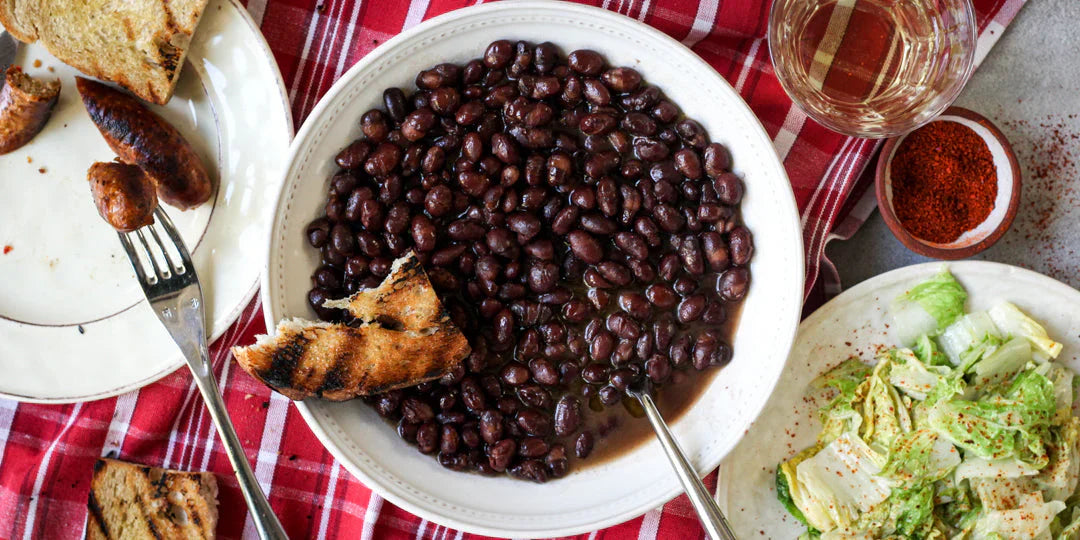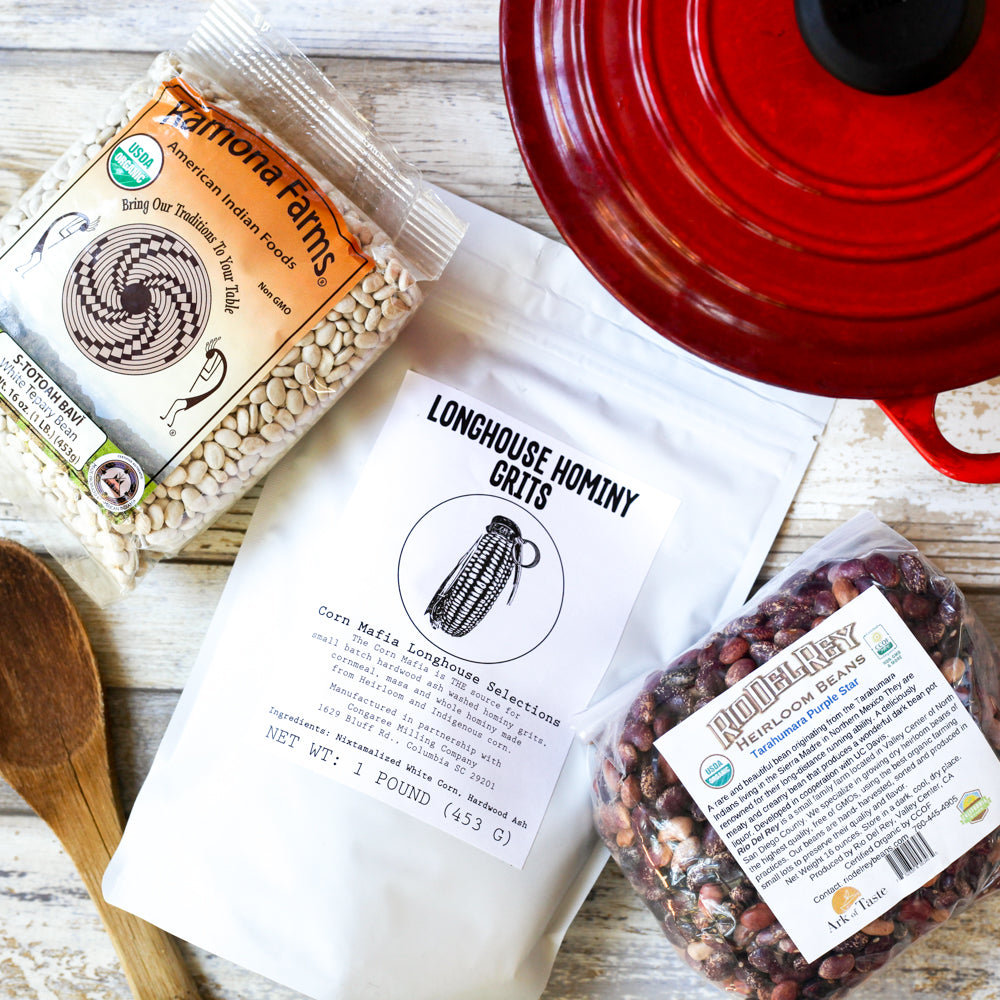10.99 FLAT RATE SHIPPING
10.99 FLAT RATE SHIPPING
SHOP

Traditional Tolosa Bean Stew
March 09, 2022 3 min read
The Tolosa is impossible to find. We were lucky enough to get a small amount for the lucky folks in the heirloom bean and grain club this year. If you are fortunate enough to get your hands on some (you may have to fly to spain to do it) you are in for a treat!
There are many famous beans in the world but few beans are as celebrated as the Tolosa. Basques take their beans seriously but the Tolosa is elevated to an almost religious level. It is so revered that each year the tiny town of Tolosa located in the Basque province of Gipúzkoa, pulls out all the stops for a Babarrunaren Astea, "week of the bean." They even have their own "Brotherhood of the Bean" which produces delicious vats of the iconic Tolosa stew for the festival.
The Atlantic pronounce this legendary legume the most famous bean in Spain a decade ago. Ironically the Tolosa originated in the new world, not Spain or France. It was brought to the region from Venezuela two centuries ago, along with the traditional method of cultivating it with corn.
I'm struck by how similar the Tolosa looks to the heritage Oaxacan black bean from January. They both resemble shiny black beads with a trademark single white spot and they almost too pretty to eat. As much as I love the Oaxacan black though the Tolosa is the creamiest most flavorful bean I've ever had. The difference in appearance is the color. Black beans from Tolosa aren’t actually black. These famous legumes are really a beautiful dark purple and you'll certainly find a few in your bag that are more lavender than black. After the traditional long slow simmer in salted water and olive oil, they’ll be swimming in a velvety lavender tinted broth worth lapping up with bits of crusty bread. One bite and you'll see why these buttery delicate beans have become so famous. They are now grown in other parts of Europe but they are nearly impossible to find in the US, even imported. Lucky for you the folks at Boonville Barn Collective are obsessed with all things Basque and we got our hands on a small quantity this year.
WHAT TO DO WITH THEM
Like so much of the best food from Spain, they are traditionally treated very simply. Just water, salt, olive oil and beans simmered low and slow for 3 hours. No garlic, tomatoes, ham hock or even a bayleaf. They are traditionally served with sausage and braised cabbage.
- 1 pound Tolosa Beans
- 6 Cups Water
- 1 Tablespoon Salt
- 1/4 cup olive oil
- Rinse one pound of Tolosa beans and put in a thick bottom pot or dutch oven. Traditionally they are cooked in a clay pot. Add 6 cups of water, salt and a generous pour of good olive oil.
- Bring to a boil then simmer for 3 hours until silky and soft. NEVER stir the beans ever or they will break. You can gently shake the pot to check the water level from time to time but no stirring at all. Keep a kettle nearby with warm water in it and add from time to time as needed to keep the beans submerged.
- After they are done cooking allow to cool for 20 minutes so that the broth can thicken in to a delicious stew.
Braised Cabbage
- 1 head of cabbage (nappa cabbage works very well)
- 2 cloves garlic minced
- olive oil
- Salt and Piment d'Ville.
- Cut the cabbage into strips and wash rigorously to make sure any critters haven't found their way inside. Cabbage worms love to hid in there.
- Heat a skillet with a tightly fitting lid on medium heat with a drizzle of olive oil in the bottom. After it is completely heated add the garlic and saute for 30 seconds until fragrant but not browning. If the garlic browns then the skillet is too hot, start over with new garlic.
- Add the cabbage and put the lid on. Wait 2 minutes and turn the cabbage with tong to evenly braise in the olive oil.
- When it is just wilted but still vibrant green remove from the stove, add salt and Piment d'Villeto taste. Add a sprinkle of pinment d'espellet on top before serving.
Traditional Tolosa Bean Stew
Rated 5.0 stars by 1 users
Category
Main Course
Cuisine
Spanish
The Tolosa is impossible to find. We were lucky enough to get a small amount for the lucky folks in the heirloom bean and grain club this year. If you are fortunate enough to get your hands on some (you may have to fly to spain to do it) you are in for a treat!

Ingredients
Directions
FOR THE BEANS
Rinse one pound of Tolosa beans and put in a thick bottom pot or dutch oven. Traditionally they are cooked in a clay pot. Add 6 cups of water, salt and a generous pour of good olive oil.
Bring to a boil then simmer for 3 hours until silky and soft. NEVER stir the beans ever or they will break. You can gently shake the pot to check the water level from time to time but no stirring at all. Keep a kettle nearby with warm water in it and add from time to time as needed to keep the beans submerged.
After they are done cooking allow to cool for 20 minutes so that the broth can thicken in to a delicious stew.
BRAISED CABBAGE
Cut the cabbage into strips and wash rigorously to make sure any critters haven't found their way inside. Cabbage worms love to hid in there.
Heat a skillet with a tightly fitting lid on medium heat with a drizzle of olive oil in the bottom. After it is completely heated add the garlic and saute for 30 seconds until fragrant but not browning. If the garlic browns then the skillet is too hot, start over with new garlic.
Add the cabbage and put the lid on. Wait 2 minutes and turn the cabbage with tong to evenly braise in the olive oil.
When it is just wilted but still vibrant green remove from the stove, add salt and Piment d'Villeto taste. Add a sprinkle of pinment d'espellet on top before serving.
Recent Articles
About Us
Foodocracy is dedicated to creating a more sustainable and independent food system. We support small, independent farms across the nation.
Related Recipes
Get impossible to find beans and grains shipped direct to your doorstep each month from small family farms.
We support small, family owned farms across the nation. Did you know that farmers only make an average of 10 cents on every dollar you spend at the supermarket? Working directly with farms and not middle men ensures that more money goes back to the people actually growning your food.
Get 10% Off
Sign up for delicious recipes and special offers.
**Regularly priced items only.









